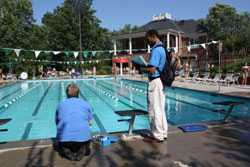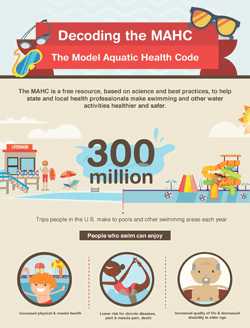Features About the Model Aquatic Health Code (MAHC)
These feature stories highlight how states and localities can use the Model Aquatic Health Code (MAHC) to help keep swimming healthy and fun.
Current Feature

New CDC Guidance for Healthy Pools
At the request of local and state health departments and the aquatics industry, CDC led a national effort to develop a Model Aquatic Health Code (MAHC) to maintain swimming's perks while reducing dangers that can occur at pools and other aquatic venues.
Past Features
CDC Guidance for Healthy Pools – 2014
 Government agencies and the aquatics industry can help keep swimming healthy and fun. Few things are more refreshing than a swim in a cool, clear pool on a sweltering hot day. Swimming is an excellent form of exercise: it is low impact on the joints, naturally incorporates resistance training, and allows you to stay cool while getting your heart pumping. At the request of local and state health departments and the aquatics industry, CDC led a national effort to develop a Model Aquatic Health Code to maintain swimming's perks while reducing dangers that can occur at pools and other aquatic venues.
Government agencies and the aquatics industry can help keep swimming healthy and fun. Few things are more refreshing than a swim in a cool, clear pool on a sweltering hot day. Swimming is an excellent form of exercise: it is low impact on the joints, naturally incorporates resistance training, and allows you to stay cool while getting your heart pumping. At the request of local and state health departments and the aquatics industry, CDC led a national effort to develop a Model Aquatic Health Code to maintain swimming's perks while reducing dangers that can occur at pools and other aquatic venues.
What is the MAHC?
The MAHC is a free resource to make swimming healthier. It is a set of voluntary guidelines, not a federal law. This means government agencies can choose to adopt none, some, or all of it. They can use it to:
- Create or update existing pool codes.
- Incorporate the latest science into their pool inspection and safety programs.
Aquatics industry leaders don't have to wait for a government agency to adopt the MAHC. They can implement key MAHC elements now to start improving health and safety at their facilities.
What is in the MAHC?
The MAHC includes voluntary guidelines for:
- Public swimming pools
- Pools, hot tubs, and spas in hotels, apartment complexes, and neighborhoods
- Waterparks
- Other aquatic facilities
The guidelines address:
- Design and construction, such as secondary disinfection systems to kill chlorine-tolerant organisms and reduce outbreaks.
- Operations and maintenance, such as lifeguarding standards to reduce drowning.
- Policies and management, such as training for pool operators to reduce pool chemical accidents, pool closures, and other issues.
The MAHC also includes a summary of the scientific rationale for each guideline.
 What are the benefits of the MAHC?
What are the benefits of the MAHC?
Benefits of using the MAHC are that it's free, voluntary, and science based. In the short term, it may help reduce pool closures. Longer term, CDC expects that the MAHC could drive reductions in:
- Drowning, a leading cause of injury-related death for children 1-14 years, second only to motor vehicle crashes. Non-fatal drowning can cause brain damage resulting in learning disabilities or even permanent loss of basic functioning.
- Waterborne illness outbreaks associated with pools, which have increased from an average of 12 outbreaks a year to 41. A single outbreak can sicken thousands.
- Pool chemical injuries, which cause nearly 5,000 emergency department visits a year. Children account for nearly half of those visits.
Want to learn more? Visit these sites for more information:
- Page last reviewed: August 17, 2016
- Page last updated: August 17, 2016
- Content source:


 ShareCompartir
ShareCompartir
